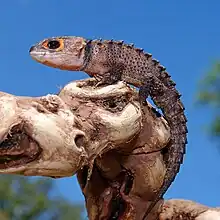Red-eyed crocodile skink
Tribolonotus gracilis, commonly known as the red-eyed crocodile skink, is a species of skink that is sometimes kept as an exotic pet. It is endemic to New Guinea, where it lives in tropical rainforest habitats. It was first described by Nelly de Rooij in 1909.[1]
| Red-eyed crocodile skink | |
|---|---|
 | |
| Scientific classification | |
| Domain: | Eukaryota |
| Kingdom: | Animalia |
| Phylum: | Chordata |
| Class: | Reptilia |
| Order: | Squamata |
| Family: | Scincidae |
| Genus: | Tribolonotus |
| Species: | T. gracilis |
| Binomial name | |
| Tribolonotus gracilis | |
Behavior
Tribolonotus gracilis is one of the few species of skinks that vocalize[1] when in distress. When startled, they tend to freeze and have been known to "play dead" (even when handled).[2]
Reproduction
A male red-eyed crocodile skink can be identified by the white pads (pores) on his feet.[3] Females have one working ovary (on the right), laying one egg at a time. She often curls around the egg and aggressively defends it when approached by a perceived threat. If it is uncovered, she will cover it back up.[4] Male crocodile skinks battle other males.
Captivity
Red-eyed crocodile skinks are available in the pet trade, but most are wild-caught rather than captive-bred. Handling is typically very stressful for this species and therefore discouraged.[5]
References
- The Reptile Database. www.reptile-database.org.
- "Red eyed Crocodile Skink care". CHICAGO EXOTICS ANIMAL HOSPITAL. Retrieved 2022-01-17.
- https://www.herpcenter.com/lizard-care-sheets/red-eyed-crocodile-skink-care-sheet/
- Hartdegen, Ruston W.; Russell, Matthew J.; Young, Bruce (2001-07-18). "Vocalization of the Crocodile Skink, Tribolonotus Gracilis (De Rooy, 1909), and Evidence of Parental Care". Contemporary Herpetology: 1–6. doi:10.17161/ch.vi1.11956. ISSN 1094-2246.
- Healey, Mariah. "Red-Eyed Crocodile Skink Care Sheet". ReptiFiles. Retrieved 2022-01-17.
Further reading
- de Rooij N. 1909. "Reptilien. (Eidechsen, Schildkröten und Krokodile)." Nova Guinea 5 (3): 375-383. ("Tribolonotus gracilis, n. sp.", pp. 381–382).
